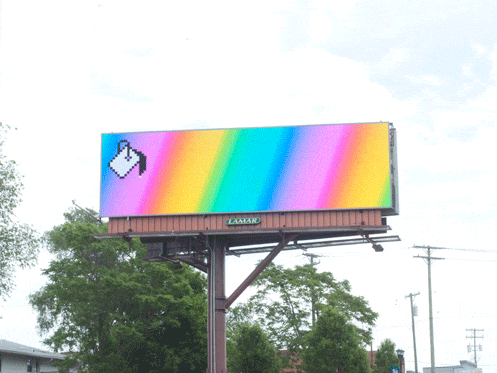
Internet
GIPHY Artist Spotlight: Anthony Antonellis Has GIF Art in His Hands (Literally)
By Celine Katzman
17 February 2017

Seeing as how the GIF has become an integral part of modern communication, PAPER is teaming up with our friends at GIPHY Arts to spotlight up-and-coming artists who are taking the medium to the next level. This week, we have Anthony Antonellis blurring the line between online and IRL.
The work of Anthony Antonellis playfully engages with network culture and investigates its relationship to IRL phenomena such as institutions, bodies, and physical objects. I asked him about his personal archival practices, GIF art preservation advocacy, and feelings on surgically integrating technology into his body.
Where did you grow up and where do you live now?
I grew up in Massachusetts on Cape Cod.
Now I live on the Internet from New York.
What does your desktop or workspace look like?
I aim for Starfleet chic over Borg brutalism.
Where do you spend most of your time on the internet?
I'd love to pretend that I lurk in some darknet underbelly, but I'm mostly binge-watching sci-fi on streaming sites. I get caught up obsessively researching topics that I find interesting, and like to create lists and archive things for no reason. Late at night, I like to browse the Wayback Machine.
How long have you been making GIFs and making art? Can you describe the relationship between those two practices and your process in general?
My first artwork sale was at age 5 when I setup a booth at the end of my driveway and sold drawings of rooster heads for a quarter. My first GIFs were made for my high school art club, created using Ulead GIF Animator.
I like the format for its unique set of restrictions and nearly universal compatibility. GIFs have an incredible reach as self-contained little packages. I don't really think of making GIFs as a distinct practice. Sometimes I make a painting, sometimes I make a GIF, and sometimes it ends up as both.
putitonapedestal.com, GIF salon, Endangered GIF preserve, are a few works you've made that treat GIFs like art-objects, putting them in museum settings or advocating for their preservation. When does a GIF become art for you?
My schoolteachers only talked about GIFs as a functional part of web design. They pronounced GIF with a soft G like jif — so I think of non-art GIFs as soft-G GIFs. GIFs that are contextualized as artwork I pronounce with a hard-G. Endangered GIF Preserve and Public Domain are sites where I aim to convert soft-G GIFs into hard-G art GIFs.
GIFs still get treated as a low form of art making. With works like putitonapedestal.com I wanted to elevate their status. Mimicking museum conventions was one of the methods to keep them from remaining passive or invisible. It can be as simple as adding a frame.
Many of the GIFs on your GIPHY artist page contain collaged, appropriated images. Do these come from different sources, or any one in particular? Is the history of the circulation of these images important to you? If so, do you keep an archive?
I source from all over the place – video sites, images searches, screenshots – wherever. Usually I know what I want and then go hunting for it. Familiarity is important to me, and I love to obsessively collect and archive assets.
Sometimes I'll stage photos in my studio, capture video, scan things in, render or draw what I need. I really like incorporating items I've owned, so whenever I can swap out a stock photo for something of mine, I prefer it. The object gets to live a new life as a GIF movie star.
What originally motivated you to manifest digital media IRL in your art practice?
I find all things tech super exciting, so it was inevitable that my practice would connect to the internet. Digital work can reach and engage with an expansive audience online. In the gallery, file based work is transmitted faster and with a smaller carbon footprint than shipping crates. Works like Moneybrick and Document also allow the audience to keep part of the work or produce it themselves.
You have had a scannable net art chip implanted in your hand since 2013. Has that evolved any of your previous conceptions about bodies and technology? Do you feel optimistic or anxious?
The net art implant runs on an ever-obsoleting device, one that is conceptually destined to become more of a time capsule than an enduring wearable. Integrating tech into the body is cool, but interacting with it is cooler.
I'm happy to see more and more technology trying to adapt to the body. A lot has changed since 2013. Companies are trying to figure out where we'll allow devices on the surface of our bodies. Some tech feels familiar and seamless, while others feel awkward and invasive. Wearable tech is still going through puberty, it's getting pushed in or strapped on wherever it'll fit.
I'm cautiously optimistic. 🙃
Which is your favorite GIF that you've made?
The first GIF that I loaded onto the net art implant is special to me, it's my website favicon .